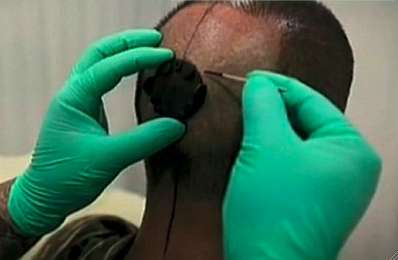
Legalization of Industrial Hemp Draws More Farmers Who Are Unfamiliar With It
Rerolled from a High Times Original Article
CLAYTON TOWNSHIP, Mich. (AP) — Dave Crabill and two business partners started small for their first foray into farming hemp, growing two strains of the now-legal cousin of marijuana on an acre along a dirt road outside the industrial city of Flint.
The endeavor was not easy. Flooding from record rain stunted some plants. Crabill and others had to carefully walk the field and uproot 1,000 undesirable males, a third of the plants, to protect more valuable females. Some plants were stolen. And it’s still not clear whether they will make money from the effort, which Crabill likened to “planting $20 bills and hoping to harvest $50.”
“That’s why we did the 1 acre,” said Crabill, who
runs a small marketing company and is among more than 500 people who
registered this year as hemp growers in Michigan, many hoping to
capitalize on the growing demand for the extract CBD. “Something
manageable. We can make mistakes and it won’t kill us. … We’re all
going to be smarter next year.”
The legalization of industrial hemp in the U.S. less than a year ago has sparked interest from both traditional farmers and newbies like Crabill. The early stages are proving tricky, but up for grabs is a lucrative market, one that could grow more than five-fold globally by 2025 — driven by demand for CBD. The compound, which doesn’t cause a high like that of marijuana, is hyped as a health product to reduce anxiety, treat pain and promote sleep.
The U.S. is the biggest hemp-importing country, and even before the
cannabis plant was fully legalized federally, some states ran pilot
programs under the 2014 farm bill. Last month, the U.S. government
finalized an interim national regulatory framework that is expected to
pave the way for the crop’s widespread commercialization starting as
early as 2020.
In Michigan, farmers who participated in the
state’s first growing season since World War II cover the gamut —
including cannabis enthusiasts and large-scale operators who want to
diversify beyond low-price commodities.
For attorney Keith Hagen
and his two farmer brothers, branching out past sugar beets, wheat and
dry beans was primarily a financial decision. They founded Hempure Farm
in Ubly and grew 340 acres (140 hectares) of hemp, the most statewide.
“There’s
not a lot of money being made in any crop right now. The margins are so
small … and then you start piling on tariffs and those margins even
get smaller,” Hagen said. “So when something new like hemp popped up,
well they’ve got the agricultural expertise. It then just turned into a
matter of learning as much as you can on how to do this.”
Producing
hemp, especially for CBD extraction, is labor-intensive. Obtaining
high-quality seeds can be difficult and expensive. Weed control is an
issue; little is known about safely or legally using pesticides. Before a
crop is harvested, it’s tested for THC, the chemical in cannabis that
causes a high. If the level is “hot,” above 0.3%, the plants must be
destroyed.
“It’s incredibly complicated,” Hagen said, pointing to
“countless minefields” facing farmers, many of whom “will probably lose
their shirt, for lack of a better term.”
Vote Hemp says more than
30 states issued 17,800 licenses to farmers and researchers in the wake
of hemp’s legalization, more than quintuple the 2018 figure. Of the half
a million acres (202,350 hectares) covered, though, an estimated
295,000 (119,000 hectares) weren’t planted because of limited access to
seedlings and clones, a lack of financing and a “huge number” of
inexperienced growers, according to the nonprofit advocacy group. It
estimates that about 50% to 60% of the planted acres, or 120,000 (48,560
hectares) to 144,000 (58,280 hectares), will be harvested, once crop
failures, non-compliant plants and other factors are factored in.
The
U.S. Department of Agriculture’s newly issued interim rules to
facilitate hemp production will provide much-needed guidance on testing,
background checks and other issues.
The industry also is closely
tracking the U.S. Food and Drug Administration. Though products
containing CBD are already in stores and sold online, the agency says
CBD-infused foods, drinks and dietary supplements are illegal. It’s
exploring ways that the compound might officially be allowed.
“There
is a bit of a medicinal market and there is a bit of an almost
salon-type market,” said Hagen, who expects to produce about 1.5 million
dried pounds (680,000 kilograms) of hemp this year for use in products
such as lotions and oils. “The real launching point, though, is when the
FDA allows CBD to be put into real consumable products. That’s where
we’ll really see what this can do.”
Ron Bates, director of the
Michigan State University Extension’s Agriculture and Agribusiness
Institute, said that would-be growers should have contracts in place in
advance.
“You just don’t harvest this stuff and take it to the
elevator and sell it,” he said. “The market infrastructure’s just not
there yet.”
For now, many states are playing catch-up.
“This is really a learning year for everybody,” said Gina Alessandri, Michigan’s industrial hemp program director. “There still are a lot more questions than answers for many people.”
By David Eggert
The post Legalization of Industrial Hemp Draws More Farmers Who Are Unfamiliar With It appeared first on High Times.
Rerolled from High Times